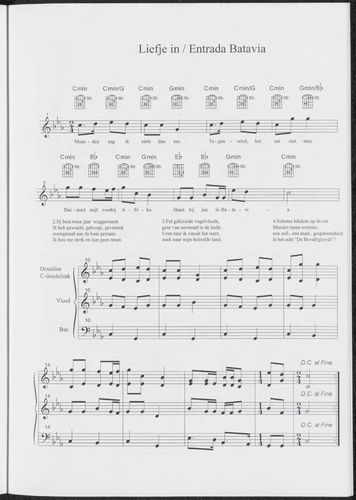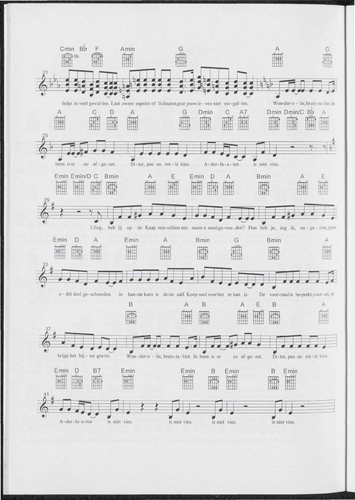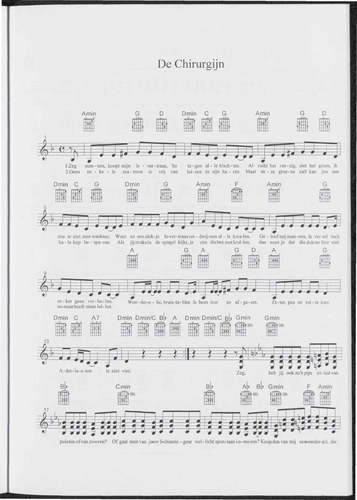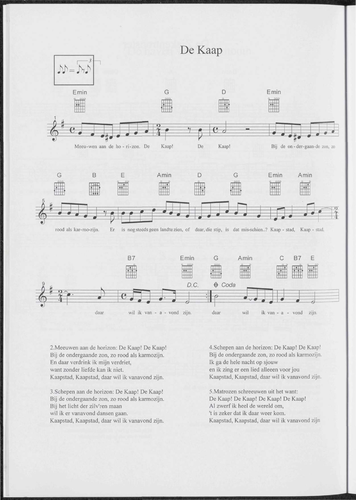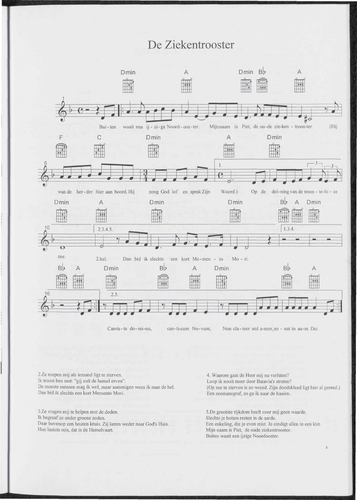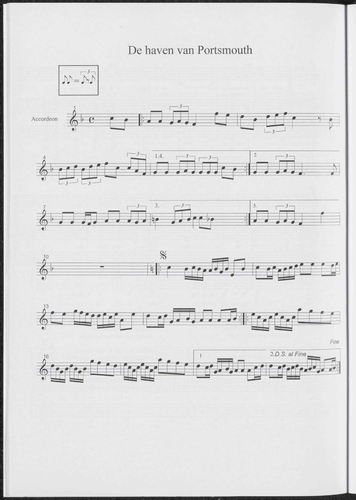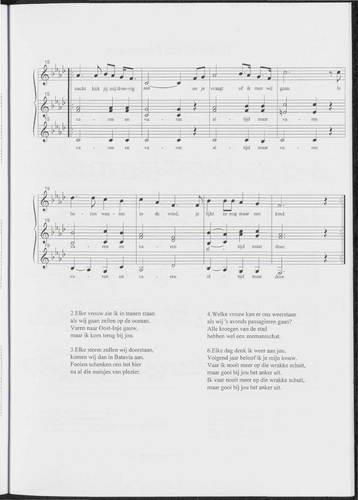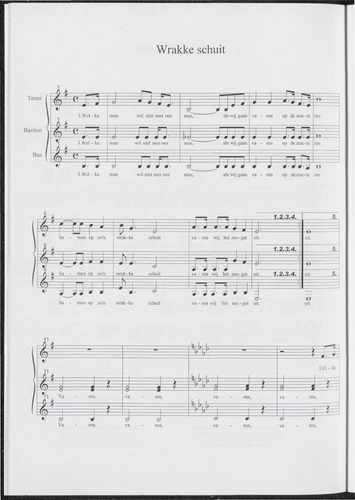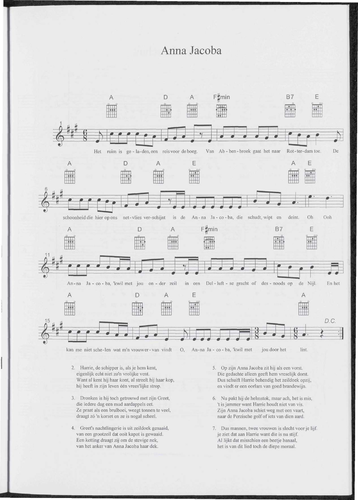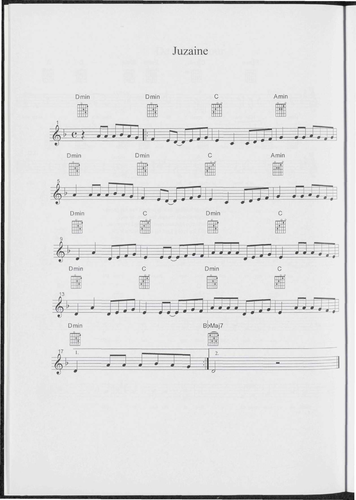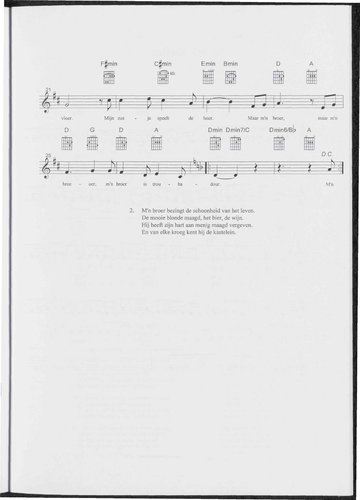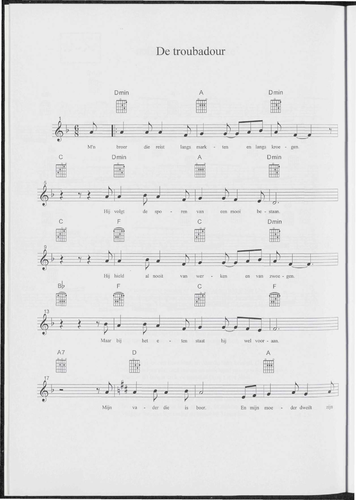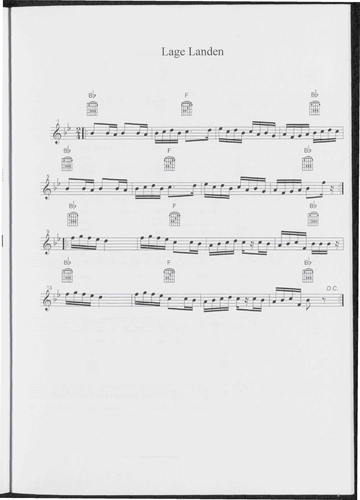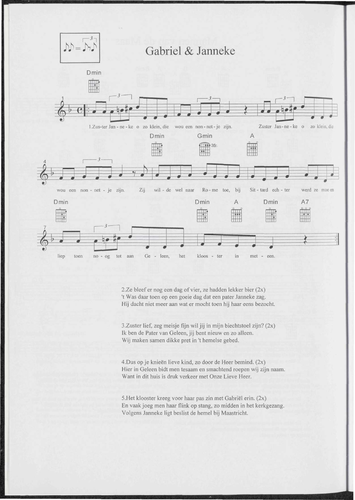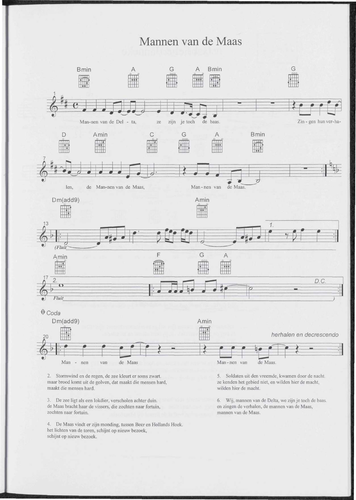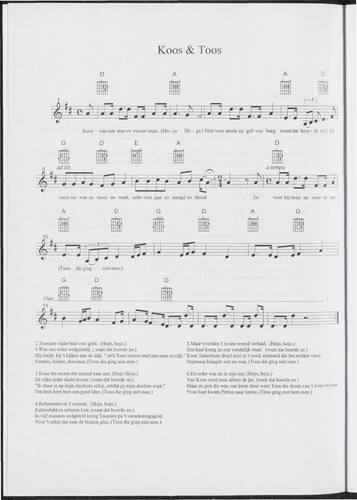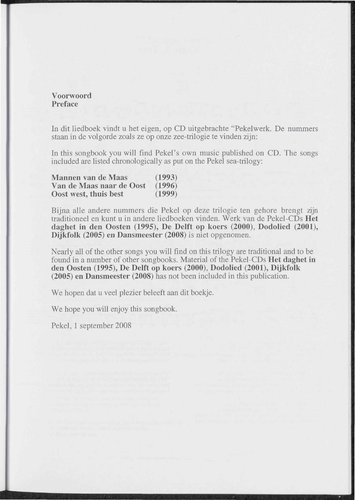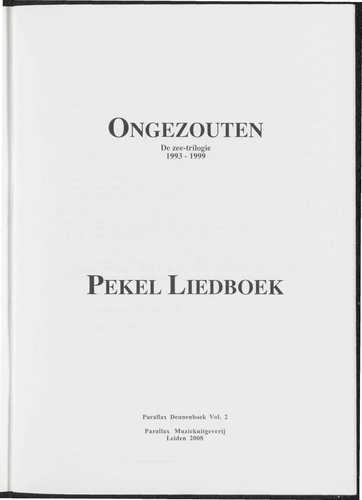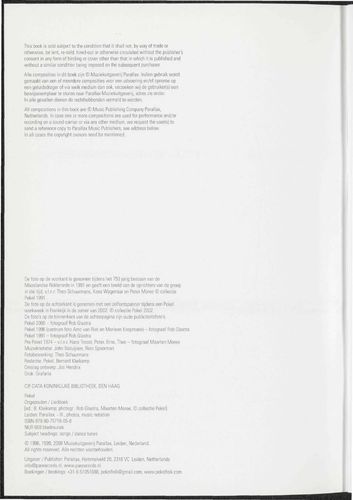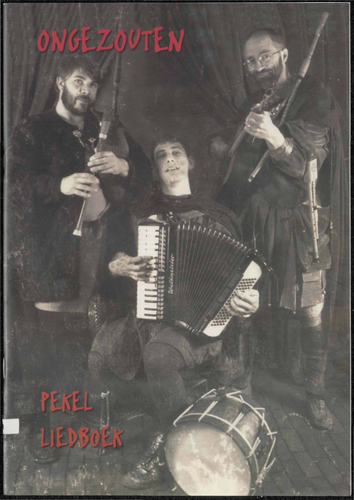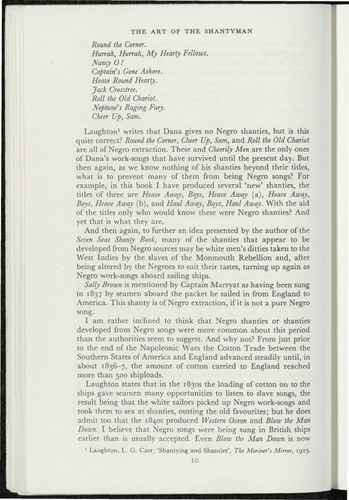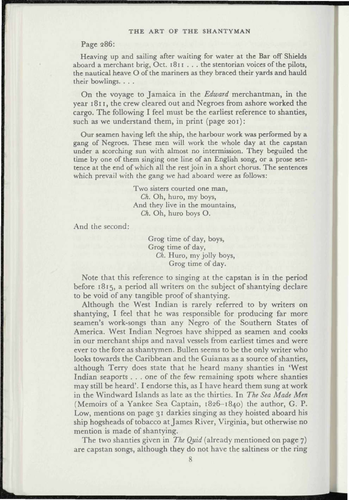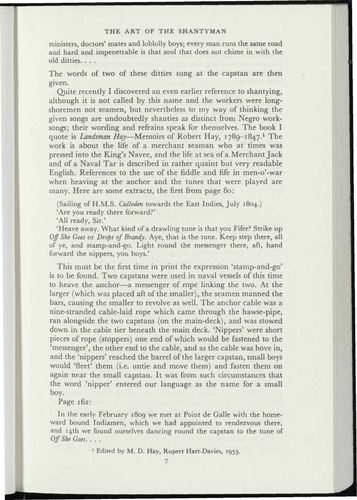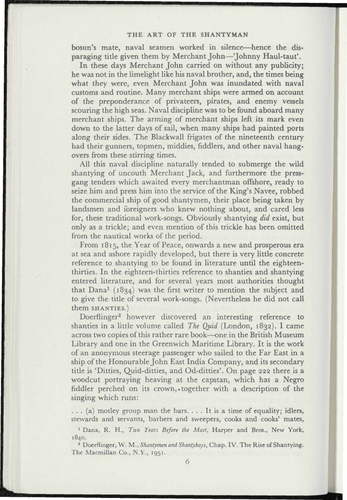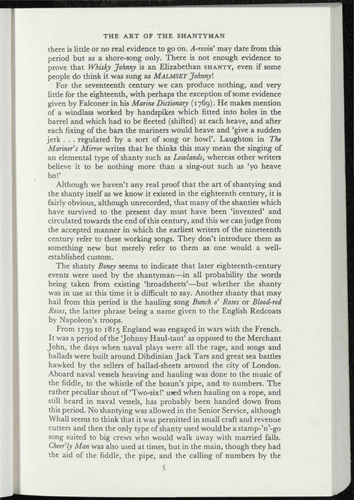Beeld en geluid
Archieven.nl bevat verschillende bronnen waarin Beeld en Geluid centraal staan. Zo kunt u bijvoorbeeld denken aan foto’s, film of een toespraak op een geluidscassette. Op deze pagina treft u al het beeld en geluid aan van diverse archiefdiensten.
Filter: Shanty Nederlandx
8.107 bestanden
sorteren op:
057 Ongezouten De Zee Trilogie

Ongezouten De Zee Trilogie, Liefje In / Entrada Batavia
Titel:
Ongezouten De Zee Trilogie
Ondertitel:
Liefje In / Entrada Batavia
Naam uitgever:
Muziekuitgeverij Parallax
Jaar van uitgave:
1996
Omschrijving:
Bladmuziek en Liedtekst
Aantal pagina's:
44
Paginanummer:
21
Taal:
Nederlands
Druk:
3e druk
Plaats van uitgave:
Leiden
Auteur:
Folkgroep Pekel en Bernard Kleikamp
Organisatie: Shanty Nederland
laatste wijziging 20-02-2023
1 gedigitaliseerd
057 Ongezouten De Zee Trilogie

Ongezouten De Zee Trilogie, De Chirurgijn
Titel:
Ongezouten De Zee Trilogie
Ondertitel:
De Chirurgijn
Naam uitgever:
Muziekuitgeverij Parallax
Jaar van uitgave:
1996
Omschrijving:
Bladmuziek en Liedtekst
Aantal pagina's:
44
Paginanummer:
20
Taal:
Nederlands
Druk:
3e druk
Plaats van uitgave:
Leiden
Auteur:
Folkgroep Pekel en Bernard Kleikamp
Organisatie: Shanty Nederland
laatste wijziging 20-02-2023
1 gedigitaliseerd
057 Ongezouten De Zee Trilogie

Ongezouten De Zee Trilogie, De Chirurgijn
Titel:
Ongezouten De Zee Trilogie
Ondertitel:
De Chirurgijn
Naam uitgever:
Muziekuitgeverij Parallax
Jaar van uitgave:
1996
Omschrijving:
Bladmuziek en Liedtekst
Aantal pagina's:
44
Paginanummer:
19
Taal:
Nederlands
Druk:
3e druk
Plaats van uitgave:
Leiden
Auteur:
Folkgroep Pekel en Bernard Kleikamp
Organisatie: Shanty Nederland
laatste wijziging 20-02-2023
1 gedigitaliseerd
057 Ongezouten De Zee Trilogie

Ongezouten De Zee Trilogie, De Kaap
Titel:
Ongezouten De Zee Trilogie
Ondertitel:
De Kaap
Naam uitgever:
Muziekuitgeverij Parallax
Jaar van uitgave:
1996
Omschrijving:
Bladmuziek en Liedtekst
Aantal pagina's:
44
Paginanummer:
18
Taal:
Nederlands
Druk:
3e druk
Plaats van uitgave:
Leiden
Auteur:
Folkgroep Pekel en Bernard Kleikamp
Organisatie: Shanty Nederland
laatste wijziging 20-02-2023
1 gedigitaliseerd
057 Ongezouten De Zee Trilogie

Ongezouten De Zee Trilogie, De Ziekentrooster
Titel:
Ongezouten De Zee Trilogie
Ondertitel:
De Ziekentrooster
Naam uitgever:
Muziekuitgeverij Parallax
Jaar van uitgave:
1996
Omschrijving:
Bladmuziek en Liedtekst
Aantal pagina's:
44
Paginanummer:
17
Taal:
Nederlands
Druk:
3e druk
Plaats van uitgave:
Leiden
Auteur:
Folkgroep Pekel en Bernard Kleikamp
Organisatie: Shanty Nederland
laatste wijziging 20-02-2023
1 gedigitaliseerd
057 Ongezouten De Zee Trilogie

Ongezouten De Zee Trilogie, De Haven Van Portsmouth
Titel:
Ongezouten De Zee Trilogie
Ondertitel:
De Haven Van Portsmouth
Naam uitgever:
Muziekuitgeverij Parallax
Jaar van uitgave:
1996
Omschrijving:
Bladmuziek
Aantal pagina's:
44
Paginanummer:
16
Taal:
Nederlands
Druk:
3e druk
Plaats van uitgave:
Leiden
Auteur:
Folkgroep Pekel en Bernard Kleikamp
Voorbeeld : Klik op de tekst voor meer
Organisatie: Shanty Nederland
laatste wijziging 20-02-2023
1 gedigitaliseerd
057 Ongezouten De Zee Trilogie

Ongezouten De Zee Trilogie, Wrakke Schuit
Titel:
Ongezouten De Zee Trilogie
Ondertitel:
Wrakke Schuit
Naam uitgever:
Muziekuitgeverij Parallax
Jaar van uitgave:
1996
Omschrijving:
Bladmuziek en Liedtekst
Aantal pagina's:
44
Paginanummer:
15
Taal:
Nederlands
Druk:
3e druk
Plaats van uitgave:
Leiden
Auteur:
Folkgroep Pekel en Bernard Kleikamp
Organisatie: Shanty Nederland
laatste wijziging 20-02-2023
1 gedigitaliseerd
057 Ongezouten De Zee Trilogie

Ongezouten De Zee Trilogie, Wrakke Schuit
Titel:
Ongezouten De Zee Trilogie
Ondertitel:
Wrakke Schuit
Naam uitgever:
Muziekuitgeverij Parallax
Jaar van uitgave:
1996
Omschrijving:
Bladmuziek en Liedtekst
Aantal pagina's:
44
Paginanummer:
14
Taal:
Nederlands
Druk:
3e druk
Plaats van uitgave:
Leiden
Auteur:
Folkgroep Pekel en Bernard Kleikamp
Organisatie: Shanty Nederland
laatste wijziging 20-02-2023
1 gedigitaliseerd
057 Ongezouten De Zee Trilogie

Ongezouten De Zee Trilogie, Anna Jacoba
Titel:
Ongezouten De Zee Trilogie
Ondertitel:
Anna Jacoba
Naam uitgever:
Muziekuitgeverij Parallax
Jaar van uitgave:
1996
Omschrijving:
Bladmuziek en Liedtekst
Aantal pagina's:
44
Paginanummer:
13
Taal:
Nederlands
Druk:
3e druk
Plaats van uitgave:
Leiden
Auteur:
Folkgroep Pekel en Bernard Kleikamp
Organisatie: Shanty Nederland
laatste wijziging 20-02-2023
1 gedigitaliseerd
057 Ongezouten De Zee Trilogie

Ongezouten De Zee Trilogie, Juzaine
Titel:
Ongezouten De Zee Trilogie
Ondertitel:
Juzaine
Naam uitgever:
Muziekuitgeverij Parallax
Jaar van uitgave:
1996
Omschrijving:
Bladmuziek
Aantal pagina's:
44
Paginanummer:
12
Taal:
Nederlands
Druk:
3e druk
Plaats van uitgave:
Leiden
Auteur:
Folkgroep Pekel en Bernard Kleikamp
Voorbeeld : Klik op de tekst voor meer
Organisatie: Shanty Nederland
laatste wijziging 20-02-2023
1 gedigitaliseerd
057 Ongezouten De Zee Trilogie

Ongezouten De Zee Trilogie, De Troubadour
Titel:
Ongezouten De Zee Trilogie
Ondertitel:
De Troubadour
Naam uitgever:
Muziekuitgeverij Parallax
Jaar van uitgave:
1996
Omschrijving:
Bladmuziek en Liedtekst
Aantal pagina's:
44
Paginanummer:
11
Taal:
Nederlands
Druk:
3e druk
Plaats van uitgave:
Leiden
Auteur:
Folkgroep Pekel en Bernard Kleikamp
Organisatie: Shanty Nederland
laatste wijziging 20-02-2023
1 gedigitaliseerd
057 Ongezouten De Zee Trilogie

Ongezouten De Zee Trilogie, De Troubadour
Titel:
Ongezouten De Zee Trilogie
Ondertitel:
De Troubadour
Naam uitgever:
Muziekuitgeverij Parallax
Jaar van uitgave:
1996
Omschrijving:
Bladmuziek en Liedtekst
Aantal pagina's:
44
Paginanummer:
10
Taal:
Nederlands
Druk:
3e druk
Plaats van uitgave:
Leiden
Auteur:
Folkgroep Pekel en Bernard Kleikamp
Organisatie: Shanty Nederland
laatste wijziging 20-02-2023
1 gedigitaliseerd
057 Ongezouten De Zee Trilogie

Ongezouten De Zee Trilogie, Lage landen
Titel:
Ongezouten De Zee Trilogie
Ondertitel:
Lage landen
Naam uitgever:
Muziekuitgeverij Parallax
Jaar van uitgave:
1996
Omschrijving:
Bladmuziek
Aantal pagina's:
44
Paginanummer:
9
Taal:
Nederlands
Druk:
3e druk
Plaats van uitgave:
Leiden
Auteur:
Folkgroep Pekel en Bernard Kleikamp
Voorbeeld : Klik op de tekst voor meer
Organisatie: Shanty Nederland
laatste wijziging 20-02-2023
1 gedigitaliseerd
057 Ongezouten De Zee Trilogie

Ongezouten De Zee Trilogie, Gabriel & Janneke
Titel:
Ongezouten De Zee Trilogie
Ondertitel:
Gabriel & Janneke
Naam uitgever:
Muziekuitgeverij Parallax
Jaar van uitgave:
1996
Omschrijving:
Bladmuziek en Liedtekst
Paginanummer:
8
Taal:
Nederlands
Druk:
3e druk
Aantal pagina's:
44
Plaats van uitgave:
Leiden
Auteur:
Folkgroep Pekel en Bernard Kleikamp
Organisatie: Shanty Nederland
laatste wijziging 20-02-2023
1 gedigitaliseerd
057 Ongezouten De Zee Trilogie

Ongezouten De Zee Trilogie, Mannen Van De Maas
Titel:
Ongezouten De Zee Trilogie
Ondertitel:
Mannen Van De Maas
Naam uitgever:
Muziekuitgeverij Parallax
Jaar van uitgave:
1996
Omschrijving:
Bladmuziek en Liedtekst
Aantal pagina's:
44
Paginanummer:
7
Taal:
Nederlands
Druk:
3e druk
Plaats van uitgave:
Leiden
Auteur:
Folkgroep Pekel en Bernard Kleikamp
Organisatie: Shanty Nederland
laatste wijziging 20-02-2023
1 gedigitaliseerd
057 Ongezouten De Zee Trilogie

Ongezouten De Zee Trilogie, Koos & Toos
Titel:
Ongezouten De Zee Trilogie
Ondertitel:
Koos & Toos
Naam uitgever:
Muziekuitgeverij Parallax
Jaar van uitgave:
1996
Omschrijving:
Bladmuziek en Liedtekst
Aantal pagina's:
44
Paginanummer:
6
Taal:
Nederlands
Druk:
3e druk
Plaats van uitgave:
Leiden
Auteur:
Folkgroep Pekel en Bernard Kleikamp
Organisatie: Shanty Nederland
laatste wijziging 20-02-2023
1 gedigitaliseerd
057 Ongezouten De Zee Trilogie

Ongezouten De Zee Trilogie,
Titel:
Ongezouten De Zee Trilogie
Naam uitgever:
Muziekuitgeverij Parallax
Jaar van uitgave:
1996
Omschrijving:
Voorwoord
Aantal pagina's:
44
Paginanummer:
5
Taal:
Nederlands
Druk:
3e druk
Plaats van uitgave:
Leiden
Auteur:
Folkgroep Pekel en Bernard Kleikamp
Organisatie: Shanty Nederland
laatste wijziging 20-02-2023
1 gedigitaliseerd
057 Ongezouten De Zee Trilogie

Ongezouten De Zee Trilogie,
Titel:
Ongezouten De Zee Trilogie
Naam uitgever:
Muziekuitgeverij Parallax
Jaar van uitgave:
1996
Omschrijving:
Verantwoording
Aantal pagina's:
44
Paginanummer:
3
Taal:
Nederlands
Druk:
3e druk
Plaats van uitgave:
Leiden
Auteur:
Folkgroep Pekel en Bernard Kleikamp
Voorbeeld : Klik op de tekst voor meer
Organisatie: Shanty Nederland
laatste wijziging 20-02-2023
1 gedigitaliseerd
057 Ongezouten De Zee Trilogie

Ongezouten De Zee Trilogie,
Titel:
Ongezouten De Zee Trilogie
Naam uitgever:
Muziekuitgeverij Parallax
Jaar van uitgave:
1996
Omschrijving:
Verantwoording
Aantal pagina's:
44
Paginanummer:
2
Taal:
Nederlands
Druk:
3e druk
Plaats van uitgave:
Leiden
Auteur:
Folkgroep Pekel en Bernard Kleikamp
Organisatie: Shanty Nederland
laatste wijziging 20-02-2023
1 gedigitaliseerd
057 Ongezouten De Zee Trilogie

Ongezouten De Zee Trilogie,
Titel:
Ongezouten De Zee Trilogie
Naam uitgever:
Muziekuitgeverij Parallax
Jaar van uitgave:
1996
Omschrijving:
Illustratie
Aantal pagina's:
44
Paginanummer:
1
Taal:
Nederlands
Druk:
3e druk
Plaats van uitgave:
Leiden
Auteur:
Folkgroep Pekel en Bernard Kleikamp
Voorbeeld : Klik op de tekst voor meer
Organisatie: Shanty Nederland
laatste wijziging 20-02-2023
1 gedigitaliseerd
049 Shanties From The Seven Seas

Shanties From The Seven Seas, Round The Corner
Titel:
Shanties From The Seven Seas
Ondertitel:
Round The Corner
Naam uitgever:
MYSTIC SEAPORT MUSEUM
Jaar van uitgave:
First Published 1961
Omschrijving:
Liedtekst
Taal:
Engels
Aantal pagina's:
430
Paginanummer:
36
Plaats van uitgave:
Connecticut
Auteur:
Collected by Stan Hugill
Organisatie: Shanty Nederland
laatste wijziging 14-02-2023
1 gedigitaliseerd
049 Shanties From The Seven Seas

Shanties From The Seven Seas, Two Sisters Courted One Man
Titel:
Shanties From The Seven Seas
Ondertitel:
Two Sisters Courted One Man
Naam uitgever:
MYSTIC SEAPORT MUSEUM
Jaar van uitgave:
First Published 1961
Omschrijving:
Liedtekst
Taal:
Engels
Aantal pagina's:
430
Paginanummer:
34
Plaats van uitgave:
Connecticut
Auteur:
Collected by Stan Hugill
Organisatie: Shanty Nederland
laatste wijziging 14-02-2023
1 gedigitaliseerd
049 Shanties From The Seven Seas

Shanties From The Seven Seas,
Titel:
Shanties From The Seven Seas
Naam uitgever:
MYSTIC SEAPORT MUSEUM
Jaar van uitgave:
First Published 1961
Omschrijving:
Shanty verklaring
Aantal pagina's:
430
Paginanummer:
33
Taal:
Engels
Plaats van uitgave:
Connecticut
Auteur:
Collected by Stan Hugill
Organisatie: Shanty Nederland
laatste wijziging 14-02-2023
1 gedigitaliseerd
049 Shanties From The Seven Seas

Shanties From The Seven Seas,
Titel:
Shanties From The Seven Seas
Naam uitgever:
MYSTIC SEAPORT MUSEUM
Jaar van uitgave:
First Published 1961
Omschrijving:
Shanty verklaring
Aantal pagina's:
430
Paginanummer:
32
Taal:
Engels
Plaats van uitgave:
Connecticut
Auteur:
Collected by Stan Hugill
Organisatie: Shanty Nederland
laatste wijziging 14-02-2023
1 gedigitaliseerd
049 Shanties From The Seven Seas

Shanties From The Seven Seas,
Titel:
Shanties From The Seven Seas
Naam uitgever:
MYSTIC SEAPORT MUSEUM
Jaar van uitgave:
First Published 1961
Omschrijving:
Shanty verklaring
Aantal pagina's:
430
Paginanummer:
31
Taal:
Engels
Plaats van uitgave:
Connecticut
Auteur:
Collected by Stan Hugill
Organisatie: Shanty Nederland
laatste wijziging 14-02-2023
1 gedigitaliseerd

 Mijn Studiezaal (inloggen)
Mijn Studiezaal (inloggen)